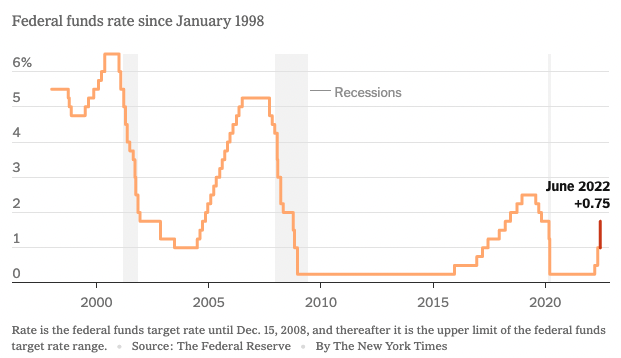Running Up That Hill
The Federal Reserve raised its benchmark federal funds rate by 0.75% (3 times the usual 0.25% notch) on June 15, putting the policy rate in the range of 1.50-1.75%. This marks the most aggressive step taken so far to fight inflation. During the press conference following the rate decision, Fed Chair Jay Powell pointed out that the Fed is “not trying to induce a recession”, but “that the environment has become more difficult, clearly, in the last four or five months”. A second 75 bps hike was kept on the table for July, but with the qualification that such large moves are unusual and that the Fed remains “data dependent”.

As we mentioned last week, the effectiveness of Fed’s policy should be measured by core inflation (through demand moderation) rather than headline inflation (the higher and more volatile figure that includes supply side elements such as food and energy). Core inflation is moving downwards slowly but headline inflation remains stubbornly high due to geopolitical factors.
According to economic projections released by the Fed, officials expect interest rates to reach 3.4% at the end of the year. Interestingly, the decision to go for a triple hike this month was largely unanimous, the lone dove (relatively) from the Federal Reserve Bank of Kansas City, voiced her preference for 50bps at this point. This points to expectations that the Fed will be hawkish for some time and potentially prioritise price stability over labour market growth.
How did markets react?
Stock prices plummeted and bond yields increased this week as investors grew increasingly worried that the Fed may not be able to pull off a soft-landing. The S&P 500 fell earlier in the week after the latest inflation print, which surprised on the upside, and put the Fed on a more aggressive path. Now officially in bear market territory, stocks rebounded slightly during Powell’s press conference on Wednesday but continued their slide later to end the week 5.8% lower and down 22.9% for the year to date period.
Are We Going Into a Recession?
The transition from stimulus-fuelled post-pandemic recovery to more sustainable growth has been difficult. Broadly speaking, the economy remains strong for now, but both inflation and the Fed’s moves to reduce it have had a real impact on households. Rates on 30-year fixed rate mortgages is just under 6%, marking the largest one week increase in three and a half decades. Accordingly, permits for new construction and applications for mortgages have fallen. More worryingly, high inflation and borrowing costs are eating into the savings buffer households have built up during the pandemic, making them much more vulnerable if and when the economy slides into a recession.
A Political Solution to Inflation?
The US Commerce Secretary said earlier this month that President Biden is considering the option of lifting tariffs to counter inflation. So far, the scope has been limited to President Trump’s tariffs on China, but no decision has been made. Economic estimates of the impact that lifting these tariffs may have is difficult to pin down exactly, as the scope of rollback has not been determined. The latest CPI reading came in at 8.6%. Removing tariffs could shave off up to 1.3% from the inflation measure, according to economists at the Peterson Institute of International Economics. It is still uncertain if companies given tariff relief will fully pass on savings to consumers. In earnings calls this year, many companies in the consumer staples category have demonstrated that they have been able to pass on higher prices for essentials to consumers without a significant dent in revenue.
Standing Out
PBoC, China’s central bank is dovish while major central banks globally are tightening monetary conditions. The Chinese equity market fared slightly better than its global counterparts with the MSCI China index down 1.2% for the week.
After aggressive moves by the Fed, PBoC abstained from cutting its key policy rate further this week, signalling reluctance to create further policy divergence from other central banks. This move was largely expected as any further dovishness from the PBoC in the face of hawks would put downward pressure on the yuan.
Covid-19 cases edged up in Shanghai and Beijing, but rumours of mass lockdowns did not materialise. Shanghai lifted the temporary lockdown of eight districts after mass testing was done, but placed housing communities with cases on a 14-day lockdown. Beijing shut down entertainment venues that were seen as the source of transmission.
Better-than-expected economic data for China may signal that peak pessimism could be over. Retail sales fell less than consensus (-6.7% vs 7.1% as major cities were in various states of restricted movement) while industrial output was surprisingly positive (+0.7% vs. -0.7% expected).
Earning Insights
We covered market moves here.
What’s Ahead?
Week of June 20, 2022:
PMIs expected from major economies globally. The Purchasing Managers Index (PMI) shows the prevailing direction of economic activity in manufacturing and service sectors. It is a forward looking indicator based on surveys. Latest PMI survey data (excluding China due to Covid-19 lockdowns) shows that global growth remains resilient, although losing some momentum. Overall, surveys are signalling early signs of improvement in supply chains, even though moderation has been sluggish.
Closer to home, Singapore’s CPI print for May will be released too.


